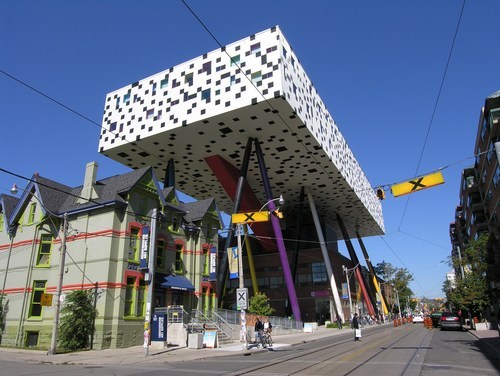
[Some think this is hideous but it’s fresh, even if it ruined the neighbourhood.]
This then, on the future of retail. With an attempt to analyse and predict [You know my opinions on that …] what malls, or shopping centres in general, may look like in, say, five years from now.
Let’s first define the inputs for my ‘analysis’:
• Rapid developments of web shops in all retail areas, not just non-food and food ;-] Yes indeed, on the surface, even food already has its web sale / home delivery channels.
• At least temporarily, an increase in one-off / small batch production items as people seek things differing from mass products.
• The previous, along with flexibility in price. Not all one-offs / small batch products will have, or require, premium prices; mass products however may be required to ever further lower their price by expectations from buyers.
• Premium-price indetermination and small volumes work only when product offerings are available to (the increasing slice that cares, of) potential buyers. But we have that Internet, and may improve on the freshness of its content. Maybe through ambient intelligence / hyperlocal (discount/sales) offerings when some model of micro-location- or -time-based ad hoc approval of pitch presentation (on the hand-, wrist-, or headheld device) and trust of micro-time and -location permanence of privacy-sensitive (i.e., all) data fed back, would actually be trusted by sufficent numbers of sufficiently affluent potential buyers to get past the network effect point.
• This implicates the expectance that shoppers will still want to go out in the first place, to socialise (of fact; not by verbal communications or so but by mere presence) with the unknown Others out there.
• Through cost increases, people transport will diminsh or will shift to cheaper means; e.g. bikes – with much smaller load carrying capacity.
• So there will be various markets out there:
Mass markets for convenience products, either at hypermarkets out of town or with home delivery – with the trend probably going towards home delivery as that saves on the nuisance to go out and be among the hoi polloi and people in general being ever more in the devolution mode of less and less exposure to the outside-of-the-house environment. (A note; I’m unsure whether fitness will move ‘back’ to indoor clubs, or will move ever more into the ‘fresh’ outside air, or both as more people (will go to!) do anything at all about their bodies ..?
Mass retail webshops, for the home delivery markets as well as for the Lm-markets as below. Also serving product comparison.
Local markets for locally produced one-off / small-batch items. Note that these may be produced in somewhat larger batches if shipping can be done within the perish timeframe, in particular for non-perishables. But no batch may be so big as to become mass as the freshness and uniqueness (only in retail is that a scale not an absolute) would diminish too much; local shoppers for hipness may not like too-large-scale availability. And note that even if shoppers would like to be surprised by the (next)^x new thing that only they have access to, they will still want to be the first to a. compare with Everything else out there, through their mobile Total Information awareness device(s), b. share their überhipness immediately, thus diminishing the newness value of their latest purchase by snapchatting it, i.e., asking for copies to become available ASAP.
Local outlets for mass-produced goods, when the product selection experience can be made a worthwhile experience in itself as with luxury goods (mass produced in sweat shops as they are, along with the mass-produced rip-offs), or when the delivery/pick-up can sufficiently add to the product experience, to warrant the shop rent. This will hold as long as opulent display of one’s Mammon worship (only; by implication) has positive residual value (net of the ridicule by ever greater masses).
• And where does this leave the Mall, or the Shopping centre (if there would be a difference) ..? The above demonstrates: Uniqueness, experience will be the thing. Locality of shops, and trust of local production and uniqueness, will be key. Hence, chain stores can survive only if they enhance the experience, or have a sufficently fluent web-purchase / local delivery experience (i.e., perfect logistics) and not too much generic stuff in stores to ruin the experience. Or provide in-store, the advantages of web shops (enormous collection, vast browsability) in combination with the premium shopping experience but also in combination with affordability! If not affordable, markets will be too small to attract sufficient clientele to warrant rent and staff; concentration will result in ever smaller enclaves of luxury shops. Shoppers will drop out, and not come from far away (don’t want the hassle and cost anymore) to shop around (among a public they don’t associate with, for products they can’t afford and not want for its lack of quality (opulence only, no content quality).
Shoppers will come for Ll- and Lm-shops, though. Aim for those..! Not big shops, but small ones; many. The low rent these may provide, and the insecurity of continuity (as real estate owner, you have control over that: rent should follow shop income, not the other way around…), are a matter of fact. Big stores will be empty, for much longer, and will cost you much more non-rent, much longer.
But oh, will web shops not vacate the shopping centre ..? No. They’re a fully-alternative channel, but they’ll lose for shopping pleasure and for freshness (newness) of products – web sites, one would need to track too frequently and too extensively (in numbers) to keep up with and people will get bored pretty quickly with that. In particular if Ll-shops do that for them anyway.
You comments, please! (see link below…)





